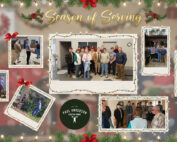“And when He had said these things, as they were looking on, He was lifted up, and a cloud took Him out of their sight.” -Acts 1:9
Today is Ascension Day. This ascension of Jesus, to say the least, confounds the critics of Christianity and Scripture. It disturbs their understanding of cosmology and science. Rockets leaving Earth’s surface normally go into orbit, or they traverse space to reach other planets in the solar system; in essence, they remain within the visible universe. In contrast, the Bible presents a number of historic events in which a door is passed through into another realm of existence – an existence every bit as real.
These events include the disappearance of the patriarch Enoch from this life to another without his traversing death. It includes Jacob actually wrestling with God with physical ramifications to himself; he also views a ladder into heaven with angels ascending and descending and the Lord gazing down upon the scene from the top of the ladder from another realm. They include Moses’ interactions with God, his face retaining for a time a physically-witnessed glow from those encounters, and also bringing back from the mountain stone tablets inscribed by the “finger” of God.
Elijah leaves his existence on earth in a chariot drawn by angelic horsemen. Centuries later, he appears with Moses on the Mount of Transfiguration, conversing with Jesus in the presence of three of His disciples. These two leave this realm again when they are enveloped in a cloud. At the exact time of Jesus’ death on the cross, saints in glory returned to their just-resurrected bodies, leaving their tombs and appearing to many others in Jerusalem.
Where was Jesus during the forty days after His resurrection when He was not appearing to His followers and the apostles? Then, we come to the few brief accounts of Jesus leaving the surface of terra firma and ascending into a cloud as He disappeared from the sight of His saints.
What are we to make of all these events of “passing through a door” between two realms of existence? What are we to think of Jesus’ words of the Kingdom of Heaven being in our very midst? Just where are these courts of heaven located? Why did Jesus ascend into the sky and disappear into a cloud as He was taking leave of earth? When He returns just as He left, why does He again appear on the clouds? These are all fair questions to think about.
The Bible says that Jesus ascended into the sky before His disciples’ eyes. They lost sight of Him when He entered a cloud. This is what their eyes saw. They were eyewitnesses. Were they all deceived by an illusion they each described without any variance? Or did it happen exactly as their eyes all witnessed? You were not there; you believe by faith in what the Scriptures relate. But there is ample evidence to believe the Scriptures as written and know billions join you in that faith.
The promise of future events rests on the history of what took place and was verbally linked by angels to what we anticipate in the future. They told them, “This same Jesus will return in the exact manner as you have seen Him go into heaven” (Acts 1).
Ascension Day reminds you to look forward with certainty to Jesus’ like return. It informs your mind and heart that there truly is a door between the world of your present experience and the courts of heaven. It suggests this other realm might actually be in our midst, removed from your sight and your hearing by the mere shift of molecules. The scientific knowledge of this may be beyond you, but the evidence suggests it.
These events of moving from one realm to the other are historical. There is a door between earth’s realm and the realm of heaven. The Ascension happened. Likewise, Christ’s return is certain. You will traverse that door yourself, and one day there will be no need of any such door.
“To whom the angels drawing nigh, ‘Why stand and gaze upon the sky?’ Alleluia! Alleluia! ‘This is the Savior,’ thus they say. ‘This is His noble triumph day.’ Alleluia! Alleluia! Alleluia! Alleluia! Alleluia!”
(Third verse of Venerable Bede’s hymn, “A Hymn of Glory Let Us Sing,” 673-735)
Stay Updated
Sign up for our monthly newsletter and weekly devotional











